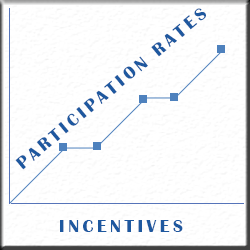August Poll of the Month: Using Incentives to Increase Response Rates
 Our August poll of the month asked about ways in which researchers incentivize survey participation. Survey research has demonstrated that some incentive is better than no incentive, and other studies have investigated how well certain types of incentives work.
Our August poll of the month asked about ways in which researchers incentivize survey participation. Survey research has demonstrated that some incentive is better than no incentive, and other studies have investigated how well certain types of incentives work.
The August poll had 83 respondents, and 60% of those who answered the poll indicated that they utilized a guaranteed incentive to increase response rates. These guaranteed incentives might be small gift cards ($5, $10), cash, or even candy.
We had one campus this past spring that used candy bars as an incentive to encourage participation in the College Senior Survey and the Your First College Year survey, and response rates for both administrations exceeded 67%! It just goes to show that providing incentives does not have to be expensive if the right marketing approach is implemented. Other campuses promise additional tickets to graduation for their senior surveys, which can be a particularly effective approach for venues with quite limited capacity.
Raffles represented the second most popular incentive used by respondents, with 40% indicating that promising entry to a raffle or drawing was once strategy they used to increase response rates. With raffles, the trick is to find the right prize that fits within the survey administration budget and piques participants’ interest. Popular raffles we see our campuses using include parking passes, iPads, and movie tickets. One strategy for survey administrators considering a raffle as an incentive is to raffle a prize every week – the earlier potential participants complete the survey, the better their odds are of winning the prize.
More than a third (36%) of respondents to the poll reported using coupons/discounts for campus or local vendors, and this approach represents an opportunity to create partnerships on and off campus. Local businesses are often looking for ways to attract students, faculty, and staff to their establishments, and this could be an effective win-win strategy for these businesses and survey administrators Likewise, surveys often have multiple stakeholders on campus, and leveraging other units’ interests in the data into tangible incentives can help create buy-in while increasing response rates.
One in ten respondents use food as an incentive, and we often see this approach used in residence halls. Resident Assistants (RAs) might host a survey pizza party, or perhaps survey researchers will host a lunch for faculty and ask them to complete the survey. Such an approach can both increase response rates and create a sense of community of campus.
We like to have fun with our monthly polls, but, to be clear, researchers have spent a great deal of time and money to understand the effectiveness of incentives at increasing response rates. For those interested, Sanchez-Fernandez et al. (2010) provide a nice overview of studies that have focused on guaranteed incentives (both pre and post), and in their own analyses they find that providing a guaranteed incentive significantly increased response rates. Porter (2004) outlines a more holistic approach to conducting an accurate, efficient, an d high-quality survey.
We hope you’ll take a couple of minutes to complete September’s poll of the month, which asks about survey marketing strategies. Check it out on our main page: www.heri.ucla.edu.
